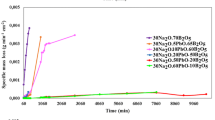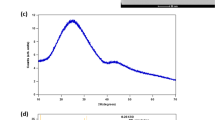Abstract
Glass has become a preferred waste form worldwide for radioactive wastes; however, there are limitations. Halogen-containing wastes can not be converted to glass because halogens (chlorides, fluorides, etc.) form poor-quality waste glasses. Furthermore, halides in glass melters often form second phases that create operating problems. A new waste vitrification process, the Glass Material Oxidation and Dissolution System (GMODS), removes these limitations by converting halogen-containing wastes into borosilicate glass and a secondary, clean, sodium-halide stream.
Similar content being viewed by others
References
W. G. Brough and S. T. Boerigter, Plutonium-Bearing Materials Feed Report for the DOE Fissile Materials Disposition Program Alternatives, UCRL-IE-120749, Lawrence Livermore National Laboratory, Livermore, California, April 1995.
C. W. Forsberg, E. C. Beahm, and G. W. Parker, Patent Application to the U.S. Office of Trademarks and Patents, U. S. Department of Commerce: The Treatment of Halogen Containing Wastes and Other Waste Materials, May, 18 1995.
C. W. Forsberg, E. C Beahm, G. W. Parker, J. Rudolph, P. Haas, G. F. Mailing, K. R. Elam, L. Ott, Direct Vitrification of Plutonium-Containing Materials With The Glass Material Oxidation and Dissolution System (GMODS), ORNL-6825, Lockheed Martin Energy Systems, Inc., Oak Ridge National Laboratory, Oak Ridge, TN, October 1995.
P. E. Queneau and A. Siegmund, JOM, 48 (4), 38 (April 1996).
G. Hantke, Gmelins Handbuch Der Anorganischen Chemie: Blei, Vol. 47, Verlag Chemie-GMBH, Weinheim, 1969.
Outokumpu Research, HSC Chemistry for Windows, Outokumpu, Finland, 1992.
W. Slough, and G. P. Jones, Chem.31, (August 1974).
W. P. Linak and J. L. Wendt, Prog. Energ. and Combust. Sci. 19, p. 145 (1993).
M. King, “Lead,” in Encyclopedia of Chemical Technology, Vol 15, eds. J. I. Kroschwitz and M. Howe-Grant, John Wiley & Sons, New York, 1995, p. 69.
Author information
Authors and Affiliations
Corresponding author
Rights and permissions
About this article
Cite this article
Forsberg, C.W., Beahm, E.C. & Rudolph, J.C. Direct Conversion of Halogen-Containing Wastes to Borosilicate Glass. MRS Online Proceedings Library 465, 131–137 (1996). https://doi.org/10.1557/PROC-465-131
Published:
Issue Date:
DOI: https://doi.org/10.1557/PROC-465-131




